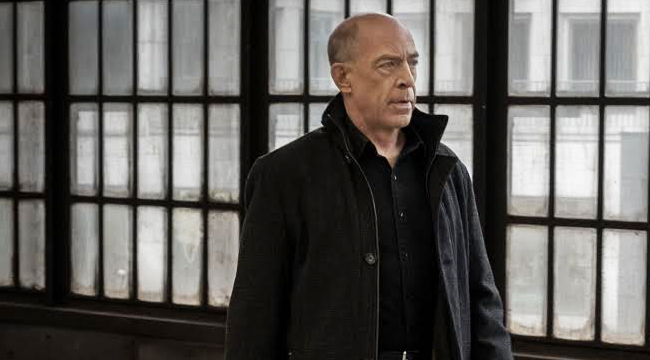
A review of the Counterpart season finale — and thoughts on season one as a whole — coming up just as soon as you break my legs without anesthesia…
“If you don’t become him, he will become you.” –Pope
I wrote my initial review of Counterpart after seeing six of these 10 episodes. At the time, I was dazzled by J.K. Simmons‘ two performances — four, really, since both Howards spent a fair amount of time impersonating one another — and enjoyed the application of stately, byzantine Cold War spy plotting to a wild sci-fi premise, but also wasn’t sure how much I cared about the supporting characters or the conspiracy arc itself.
Having watched the whole thing, my overall feelings are about the same, in that the series levels up considerably whenever Simmons is on screen and starts to buckle under the weight of all that story whenever Howard’s not around. The final episodes had to do some fairly silly things to keep all the wheels turning, particularly with Aldrich and his sidekick getting murdered before they had a chance to tell anyone that Claire is from the other side. But the Claire-centric seventh episode also worked wonders in making her story matter, in giving us a better sense of what life has been like over there since the split, and in making clear just how terrifyingly committed the conspirators are to getting their revenge on our reality. And if the show had to contort itself too much to keep her and Peter in play, then it was worth it for the finale’s callback to how Claire posed as an assault victim to fully insert herself into a relationship with Peter, with another act of violence again getting them over a (much bigger) crisis.
It’s important for the series to keep revisiting Claire and Baldwin(*), because they help illustrate the divide between the two worlds, and the show’s overall themes about roads not taken. In a lot of similar star vehicle anti-hero dramas, time spent with the supporting characters can feel painfully like what it is: a chance to lighten the top-billed actor’s workload, and a way to pad out the story to fill up an entire season. There’s some of that here — particularly before we found out that Claire was Peter’s wife — but Counterpart is by and large smart enough to try to keep everything connected to the idea of the parallel worlds and the differences between them. (No iPhones over there, but Prince is still alive!)
(*) Two Baldwin thoughts: 1) All the kudos to whoever designed her facial scar, which makes her look like she’s sneering all the time, even though she mostly tries to step back and observe; 2) I watched the first six episodes before watching all of Babylon Berlin on Netflix, and thus went from, “Baldwin’s barista girlfriend seems somewhat interesting” to “Hey, that’s Liv Lisa Fries!” Always fun when that happens.
But the draw here remains each Howard Silk learning more about the other one. The highlight of the early episodes was our Howard studying the bedroom of the other Howard’s daughter — the daughter he and his Emily lost, in a way that’s haunted and shaped him ever since — and considering the life he could have had with her. No pyrotechnics, not even any special effects, other than the amazingly expressive face of one J.K. Simmons, and it was a thing of minimalist beauty. Just as powerful was the confrontation between the two Howards in the Interface room at the end of the eighth episode, each taunting the other about how much better he is at their life: our Howard rapidly mending the family that alt-Howard spent years breaking apart, alt-Howard recognizing the affair Emily had that our Howard was too naive and lovestruck to see. The closing of the border in the wake of the parallel world’s attack on the offices in this one(*) traps each Howard on the wrong earth, which should allow season two to tap even more into the show’s richest emotional vein, even if it will be even harder to have scenes where the two Howards interact.
(*) The sequence where the two different offices consult with their respective managements about how to deal with the dying assassin trapped in No Man’s Land was structured in a way to raise the question of whether both worlds are somehow being controlled by the same entity. Or it could just be that, for all the differences between realities, they started from the same place and thus have similar computerized bureaucracies in place.
If Counterpart was just a J.K. Simmons showcase, it would be plenty compelling. But, particularly in the later episodes, the show did just enough to define the world around the two Howards to make the whole thing work, and I look forward to seeing the second half of this tale play out.
What did everybody else think?
Alan Sepinwall may be reached at sepinwall@uproxx.com. He discusses television weekly on the TV Avalanche podcast. His new book, Breaking Bad 101, is on sale now.
